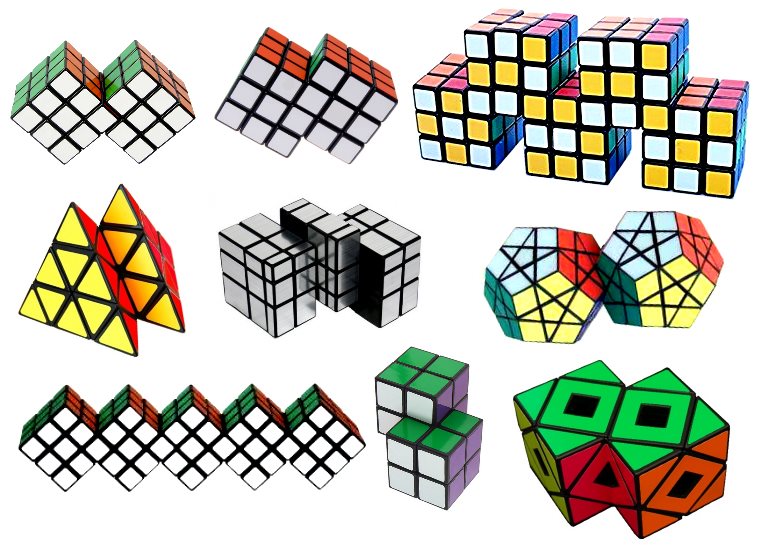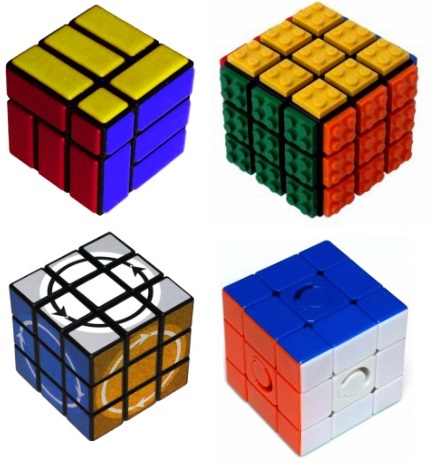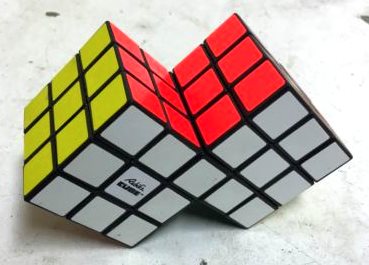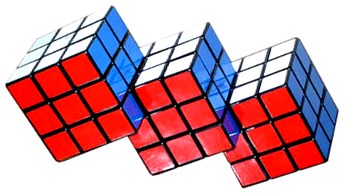Siamese Twisty Puzzles
As has been discovered in articles covering different types of puzzles that people have created based on the original Rubik’s Cube over the years, people are never satisfied with the puzzles that are available. A standard 3x3 Rubik’s Cube is uniform and symmetrical in its turning. Perhaps one of the easiest modifications to a normal Rubik’s Cube is to bandage it.

Several twisty puzzles being bandaged: Pyraminx, Mirror Cube, Pocket Cube, Megaminx, Skewb
 Bandaging puzzles involves restricting the movement that a puzzle has in order to increase its difficulty. This can be done in a number of different ways, such as restricting the directions in which moves can be made (such as the latch cube and constrained cubes) and joining previously separable pieces (such as the original Bicube, created by Uwe Méffert). Read more about these types of bandagable puzzles here.
Bandaging puzzles involves restricting the movement that a puzzle has in order to increase its difficulty. This can be done in a number of different ways, such as restricting the directions in which moves can be made (such as the latch cube and constrained cubes) and joining previously separable pieces (such as the original Bicube, created by Uwe Méffert). Read more about these types of bandagable puzzles here.
However, the creation of one type of puzzle cannot be done without at least some bandaging. These puzzles are called Siamese cubes. Arguably the world’s first modification to be created, the original Siamese cube was created just 1 year after the release of the original Rubik’s Cube. Tony Fisher showed his creation to David Singmaster, who was known as the UK’s Rubik’s Cube expert. Singmaster was fascinated by the concept and spread the word via his Rubik’s Cube newsletter. Soon after, Ernő Rubik created his own version and Ideal Toy Corporation released it under the name “Rubik’s Mate”. It is unknown whether or not Rubik independently invented the puzzle or plagiarised Fisher’s design, although Fisher has stated that he doesn’t mind if the latter is true.
Fisher’s original design opened up a whole new world of Rubik’s Cube exploration – Puzzle modifications. The original Siamese cube is fairly simple to make with two standard Rubik’s Cubes at home, however an original Rubik’s Mate (only produced for a very limited period of time, perhaps less than a year) is incredibly rare to find.

A genuine Rubik's Mate for sale on eBay for 124$ - A deal like this is hard to find
The two cubes that are used share a 1x1x3 row of pieces. Imagine a normal Rubik’s Cube, except the top-right 1x3 layer cannot be split up. This effectively “bandages” the cube, so from a solve state, the front and back layers cannot be moved. A Siamese cube is just two of these types of special bandaged puzzles stuck together, one being upside down. Because the puzzle does not have a centre axis at the connection point, the pieces from one cube cannot move to the other. This means that you can simply solve both halves like normal Rubik’s Cubes, but with 3 bandaged pieces. By keeping the bandaged 1x1x3 block on the bottom left of the cube you are currently solving, the cube can be solved with R, U and slice moves. On a standard 3x3, if a scramble only consists of R and U moves, you will be able to solve it with just R and U moves. A similar thing applies here – The 1x1x3 block can’t be split up during a scramble, therefore it can be solved without using it.
Several other Siamese cube variants have been created by both Tony Fisher and other puzzle designers. These include larger Siamese puzzles such as the Siamese 4x4, 5x5 and 6x6. Also, “Triamese” puzzles have been created, which consist of 3 cubes joined in the same way as the Siamese puzzles. This introduces an extra challenge, as the middle puzzle is bandaged in 2 places, making its solution different to the outer two. Other types of connection have been created also, such as using two bandages pieces instead of 1. Triamese variants of this type of connection make for fun and strange looking puzzles.

Triamese Rubik's Cubes sharing 2x1 blocks